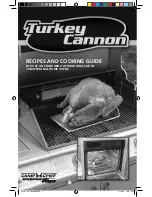
11
EN
ENGLISH
• To help keep track of the outside temperature, place an outdoor thermometer close to your cooking area. Keep a log
or history of what you cooked, the outdoor temperature, and the cooking time. This will help later down the road to
help you determine what to cook and how long it will take.
• In very cold weather, increase your preheating time by at least 20 minutes.
• Avoid lifting the lid any more than necessary. Cold gusts of wind can completely cool your grill temperature. Be
flexible with your serving time; add extra cooking time each time you open the lid.
• Have a heated platter or a dish cover ready to keep your food warm while making the trip back inside.
• Ideal foods for winter cooking are those that require little attention, such as roasts, whole chickens, ribs, and turkey.
Make your meal preparation even easier by adding simple items such as vegetables and potatoes.
3.
HOT WEATHER COOKING
As it becomes warmer outdoors, the cooking time will decrease. Proper dress is important when it gets really hot: shorts,
shirt, shoes, hat, apron and a generous slab of suntan lotion is recommended.
Follow these few suggestions on how to enjoy your grill throughout the hot months:
• Adjust your cooking temperatures downward. This helps to avoid unwanted flare-ups.
• Use a meat thermometer to determine the internal temperature of your foods. This helps in preventing your meat
from over cooking and drying out.
• Even in hot weather it is still better to cook with the lid of your grill down.
• You can keep foods hot by wrapping them in foil, and placing them in an insulated cooler. Stuff crumpled up
newspaper around the foil and this will keep food hot for 3 to 4 hours.
GRILL TEMPERATURE RANGES
Temperature readouts on the control board may not exactly match the thermometer. All temperatures listed below
are approximate and are affected by the following factors: outside ambient temperature, the amount and direction of
wind, the quality of pellet fuel being used, the lid being opened, and the quantity of food being cooked.
•
HIGH TEMPERATURE (205-260°C / 401-500°F)
This range is best used to sear and grill at a high heat. Use in tandem with the flame broiler (slide plate) for indirect or
direct flame cooking. With the
flame broiler open
, direct flame is used to create those “blue” steaks, as well as flame-
kissed vegetables, garlic toast or s’mores! When the
flame broiler is closed
, the air circulates around the barrel, resulting
in convection heat. High temperature is also used to preheat your grill, burn-off the cooking grids, and to achieve high heat
in extreme cold weather conditions.
•
MEDIUM TEMPERATURE (135-180°C / 275-356°F)
This range is best for baking, roasting, and finishing off that slow smoked creation. Cooking at these temperatures will
greatly reduce the chances of a grease flare-up. Ensure that the flame broiler slider in the closed position, covering the
slotted openings. Great range for cooking anything wrapped in bacon, or where you want versatility with control.
•
LOW TEMPERATURE (80-125°C / 176-257°F)
This range is used to slow roast, increase smoky flavor, and to keep foods warm. Infuse more smoke flavor and keep your
meats juicy by cooking longer at a lower temperature (also known as
low and slow
). Recommended for the big turkey at
Thanksgiving, juicy ham at Easter, or the huge holiday feast.
Smoking is a variation on true barbecuing and is truly the main advantage of grilling on a wood pellet grill.
Hot smoking
,
another name for
low and slow
cooking, is generally done between 80-125oC / 176-257oF. Hot smoking works best when
longer cooking time is required, such as large cuts of meats, fish, or poultry.
TIP: To intensify that savory flavor, switch to SMOKE (low) temperature range immediately after putting your food
on the grill. This allows the smoke to penetrate the meats.
The key is to experiment with the length of time you allow for smoking, before the meal is finished cooking. Some outdoor chefs
prefer to smoke at the end of a cook, allowing the food to keep warm until ready to serve. Practice makes perfect!












































